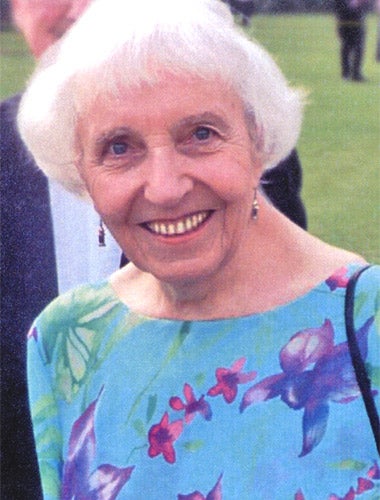Corinne Bennett: Architect who made the conservation of cathedrals her speciality

Your support helps us to tell the story
From reproductive rights to climate change to Big Tech, The Independent is on the ground when the story is developing. Whether it's investigating the financials of Elon Musk's pro-Trump PAC or producing our latest documentary, 'The A Word', which shines a light on the American women fighting for reproductive rights, we know how important it is to parse out the facts from the messaging.
At such a critical moment in US history, we need reporters on the ground. Your donation allows us to keep sending journalists to speak to both sides of the story.
The Independent is trusted by Americans across the entire political spectrum. And unlike many other quality news outlets, we choose not to lock Americans out of our reporting and analysis with paywalls. We believe quality journalism should be available to everyone, paid for by those who can afford it.
Your support makes all the difference.In 1974 Corinne Bennett became the first woman to hold the post of architect to one of the country's cathedrals. She was appointed by that sagacious Dean, Michael Stancliffe, to Winchester, one of the most ancient and breathtakingly beautiful of all our cathedrals. She came to the position through an apprenticeship in the understanding of ancient buildings that was already discernible at her Convent School in Hove, where she was a pupil after her family came to England from Canada when she was nine. How surprised she would have been to know that she would become consultant architect to Brighton Pavilion, and to the Albert Memorial, two of the most bizarre buildings in England. The range of architectural responsibilities placed on her shoulders was breathtaking.
Corinne Wilson was born in London in 1935; her father was a professor of geology. After training at the Bartlett School of Architecture in London, she worked with the architectural firm Powell and Moya, the GLC Historic Buildings section and with the Ministry of Public Buildings and Works (nowadays English Heritage). Especially relevant to her later career was her pioneering study of stone preservation in her work with the Building Research Establishment.
Her special interest in the qualities of stone, always evident on her visits to masons' lodges and quarries, sprang from her father, a professor of geology. The Tower of London, The Great Hall and Jewel Tower at Westminster, Audley End, Holyrood Palace, Bolsover Castle, the replacement Heads of Emperors carved by Michael Black at the Sheldonian in Oxford, all came under her guidance.
By the 1970s she had joined Purcell Miller Tritton, with whom she was introduced to cathedrals and their problems at Ely. She set up their office at Sevenoaks, where her tireless work for the churches of Kent brought her an MBE. For the National Trust she worked at Mompesson House in Salisbury, Mottistone Manor, Lacock Abbey, Mottisfont Abbey, in Chiddingstone village and at the Old Clergy House at Alfriston.
The Hall of the House at Alfriston is repaired as perfectly as such a work can be. In other words, you are only aware of what has had to be done after careful examination, and the new is less evident than the original.
She also held briefs at Wilton House, Charleston Farmhouse, the ruins at Cowdray and the Royal Naval Palace at Greenwich. Her devout Catholicism made it natural that Ealing Abbey and the reordering of the chapel of the English College in Rome and of St John's Seminary at Wonersh came into her hands, and latterly she chaired the Fabric Committee of St George's Chapel, Southwark, and was a member of the equivalent Committee at Westminster Cathedral. Her version of "retirement" was to become, in 1991, the National Cathedrals Architect to English Heritage, and after that, until four years ago, she was English Heritage's representative on the Cathedrals Fabric Commission – a posting requiring extensive travelling and the bringing to bear of all her experience.
She also found time to be an inspired gardener and to look after the lovely houses she shared with her husband Keith Bennett at Michelmarsh and latterly in Winchester. Corinne and Keith also had a special relationship with Corsica and its ancient churches, and another with the Franco-British Union of Architects (Corinne's mother was a French-Canadian). She was proud to be elected to the Society of Antiquaries and was also a member of the Equestrian Order of the Holy Sepulchre of Jerusalem.
Among the many shared enthusiasms of Corinne and Keith was opera, which brought them annually to Glyndebourne. Last year I discovered the occasion was going to mark Keith's birthday, and the happy party we shared was to be the last time I saw her. As always, she radiated delight.
Corinne Bennett was a thorough professional: dedicated, fearless, and at the same time a dear, warm and lovely woman. She is survived by her husband. They had no children.
There will be a Mass of Thanksgiving at St George's Roman Catholic Cathedral at Southwark on Thursday 30 September at 11am.
Pamela Tudor-Craig
Marie Corinne Gillian Wilson, architect: born London 3 March 1935; Cathedrals Architect, English Heritage 1992–96; MBE 1988; married 1979 Keith Bennett; died 10 July 2010.
Join our commenting forum
Join thought-provoking conversations, follow other Independent readers and see their replies
Comments